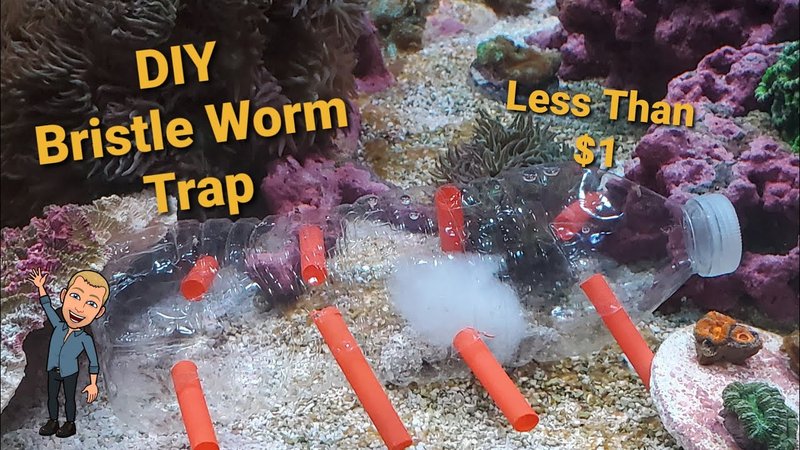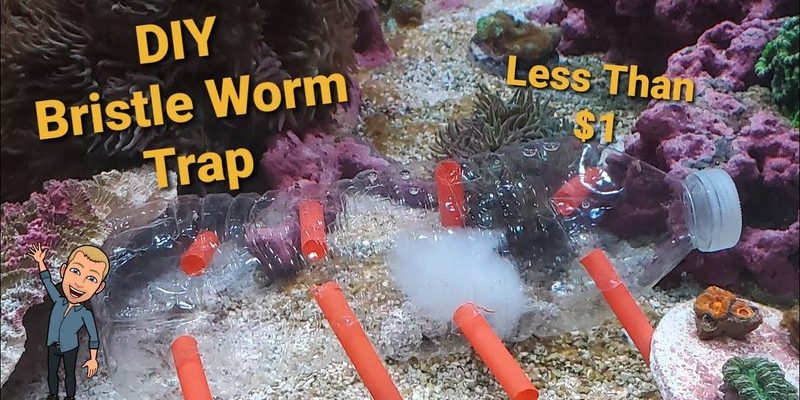
Imagine you’re sitting down with your favorite cup of coffee, and someone tells you about their nightmare with bristle worms. They’re colorful, sometimes a bit creepy, and they can appear out of nowhere. You might be wondering how to get rid of them without harming your tank’s ecosystem. That’s where DIY traps come in! With a few simple materials, you can create effective traps that’ll help you catch these little critters, all while keeping your tank safe and healthy.
Let’s dive into the world of DIY traps for bristle worms and find out how to tackle this issue head-on!
Understanding Bristle Worms
Before we jump into creating traps, it’s essential to understand what bristle worms are and why they might be a problem in your tank. These worms are part of the polychaete family, and while they can be beneficial by helping to break down organic matter, their population can explode if left unchecked, causing issues for your fish and coral.
Bristle worms can be tricky to spot since they often hide in the substrate or among rocks during the day. You might only notice them when the lights go out, and this can lead to an unpleasant surprise! Unlike some pests, these worms are not typically harmful, but excessive numbers can lead to over-competition for food. You want to keep their population in check, and that’s where traps come into play.
So, here’s the thing—you don’t need to resort to harsh chemicals or complicated traps. Instead, we’ll explore a few simple and safe DIY traps that can help you manage bristle worm populations effectively.
DIY Trap Ideas for Bristle Worms
There are several easy-to-make traps for capturing skittish bristle worms. Let’s go over a few effective methods. Each method uses common household items you probably have lying around, so no need for a shopping spree!
1. The Bottle Trap
One of the simplest traps you can create is the bottle trap. All you need is a plastic bottle, some bait, and a little creativity. Here’s how to do it:
- Take a clean plastic bottle and cut the top off just below the neck of the bottle.
- Invert the top portion and place it back inside the bottom part, creating a funnel effect.
- Add a piece of bait—like a small piece of shrimp or fish—inside the bottle.
- Submerge the trap in your aquarium, placing it near areas where you’ve seen bristle worms.
The bristle worms will be attracted to the bait, crawl in through the funnel, and won’t be able to escape. Check the trap periodically and remove any captured worms.
2. The Jar Trap
Another effective trap is the jar trap. Similar to the bottle trap, this method uses a glass jar, which can be even more attractive due to its transparency. Here’s how to create one:
- Use a small glass jar and fill it with water and a bait piece. Pro tip: the bait can be anything you think they’ll love, like fish bits or even algae tabs!
- Place the jar on its side at the bottom of your aquarium.
- Make sure it’s partially submerged and accessible for the worms.
Just like with the bottle trap, the worms will be drawn to the bait and will find it hard to climb back out once they’re in the jar. This is a low-stress way to manage your bristle worm population.
3. The DIY P.E. Trap
For a more hands-on approach, you can create a P.E. (Practical Easy) trap that uses a PVC pipe. This method is a bit more involved, but it can be effective if you have the materials on hand.
- Take a small piece of PVC pipe, about 6–10 inches long, and drill a few holes along the sides.
- Attach a piece of mesh or netting over one end to keep the worms from escaping, but still allows them to enter.
- Fill the pipe with a bit of bait and place it horizontally in your aquarium.
This trap can be particularly effective because the worms will be attracted to the bait and will enter through the holes. You can easily lift the pipe out of the tank to remove any captured worms.
Using Bait Wisely
When it comes to baiting your traps, not all options are created equal. Choosing the right bait is essential for attracting bristle worms effectively. Here are a few popular bait options:
- Fish scraps: Leftover bits of fish are irresistible to bristle worms.
- Frozen shrimp: You can break off small pieces, and they’re usually quite effective.
- Algae wafers: These are a great option if you’re dealing with a vegetarian variety of bristle worms.
Honestly, you might need to experiment a bit to see which bait works best for your specific tank situation. Practice makes perfect, and over time, you’ll learn what attracts those little worms most effectively.
Where to Place Your Traps
You might be wondering where the best spots to place your traps are. Think about the areas where bristle worms are likely to hang out. Here are some tips for optimal trap placement:
- Near rockwork: These worms love to hide among rocks and crevices. Place traps near their usual hangouts.
- At the substrate level: Setting traps close to the bottom of your tank can be highly effective.
- In low-light areas: Since bristle worms are nocturnal, try positioning your traps where it’s darker.
Leave the traps in place for a couple of days before checking them. This gives the worms enough time to find the bait and enter the traps.
Cleaning Up After Trapping
Once you’ve captured bristle worms in your traps, you’ll want to handle them appropriately. It’s important to clean both the trap and your hands after handling any captured specimens.
- Remove the worms carefully and dispose of them outside the aquarium.
- Rinse the traps with fresh water, and if needed, give them a more thorough wash with hot water.
- Don’t use soap or any cleaning products that could harm your tank.
If you’re feeling adventurous, you could even compost the worms in your garden if you want a little extra nutrient boost for your plants!
Monitoring and Maintenance
After you’ve set your traps and started catching bristle worms, the work doesn’t stop there. Regular monitoring and maintenance are key. Here are a few things to keep in mind:
- Check your traps at least once every couple of days.
- Keep an eye on the bristle worm population; if it seems to be increasing, you might need to set more traps.
- Ensure that your regular maintenance routines for your tank are in place—this can help prevent future infestations.
Consistency is crucial in keeping the bristle worm population in check. With patience and regular maintenance, you’ll be able to keep these critters at bay.
Dealing with bristle worms doesn’t have to feel overwhelming. By using these simple DIY traps, you can manage their population and keep your aquarium healthy. Remember to choose the right bait, place your traps strategically, and keep an eye on your tank’s ecosystem.
You’ve got this! With the right approach, you can enjoy a beautiful, balanced aquarium without those pesky bristle worms interfering. So grab your materials and get started on your DIY trap journey—you might just find it’s a fun and rewarding experience!

